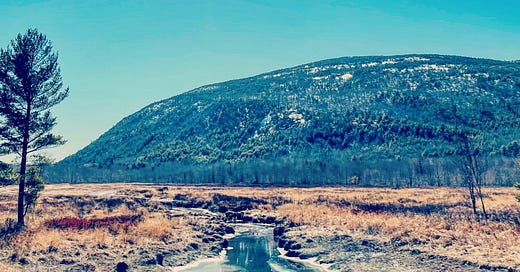Approximately 200 community members, volunteers, trail stewards and more tucked into the Bar Harbor Club on West Street in Bar Harbor July 6 to celebrate the success of Friends of Acadia’s past year and meet the non-profit organization’s new president, Eric Stiles.
During the meeting inside the Bar Harbor Club’s ball room, Gary Stellpflug received the Marianne Edwards’ award for service, striding up to the podium in his pink and white striped button-down shirt. His white mustache that couldn’t hide his initial smile as he accepted the award.
“This is not just for me… it’s for …” He pulled out a large beige linen and wiped his face, trying to compose himself, apologizing for his emotions.
But the park, its beauty, its stewardship, and the friendship and connections it makes, the stories and art and community it inspires, is something that is meant to move people to tears, to move people to look beyond their individual self, and to create connections that are bigger and full of emotion. It is meant to create the understanding that we are all together in both on its granite mountains, coast, plants and animal life, and its grandeur. Stewards and volunteers like Gary are a part of its ecosystem.
A large part of Friends of Acadia’s mission is to protect the 47,000 acres of Acadia National Park, located in Maine, homeland of the Wabanaki, and one of the national’s smallest national parks and also one of its most visited.
The Friends of Acadia website states that this protection is its goal, “We are an independent organization of passionate people, inspiring those who love this magnificent place to make a real and lasting difference for Acadia.”
And its mission? Officially?
“To preserve, protect, and promote stewardship of the outstanding natural beauty, ecological vitality, and distinctive cultural resources of Acadia National Park and surrounding communities for the inspiration and enjoyment of current and future generations.”
There are over 4,600 members of Friends of Acadia and the group has supported almost 5,000 volunteer hours doing activities like repairing 1,220 cairns on the trials and providing $35.7 million in grants since 1986.
It’s a big deal that’s celebrated every year. This year the masked crowd gathered for the first time since the start of the COVID-19 pandemic.
“It’s so beautiful to be here again,” one woman enthused sipping her wine at the social hour after the program. “What a great organization.”
Last year, despite a pandemic, about 4.1 million visitors walked the carriage roads, hiked the trails, and swam in the waters of Acadia National Park. Only two percent of them didn’t drive their own vehicle.
Back in 2016, local volunteers Jack Russell and Cookie Horner received the Marianne Edwards Award. During his remarks, Jack said, “Everyone in this room knows in your bones that things worth doing well are done through teamwork. In our work as Friends -- on Acadian trails, for new members, as advocates, in capital campaigns -- we bend together in love of place.”
The love of a place unites in times of economic distress as well. And it’s that love of place that keeps Friends of Acadia’s staff and volunteers working to preserve a place that is so special.
The National Park Service’s budget has decreased during the past decade (if you account for inflation) and Friends of Acadia has stepped in, helping with infrastructure, the Island Explorer bus service and so many other things.
How much impact does this organization have on Acadia National Park and the surrounding community?
Jack Kelley, chairman of Friends of Acadia’s board of directors says it well.
“Friends of Acadia raised significant money for the Greening Acadia Fund to help purchase electric vehicles and equipment to reduce the park’s carbon footprint. We provided critical support to the creation of the Cadillac Summit Road reservation system and funded an accessibility study to help remove barriers for those with disabilities. We also celebrated the long-awaited restoration of Acadia’s historic carriage roads and helped to host Interior Secretary Deb Haaland in her inaugural trip to Acadia.”
It’s a lot. The group has an entire impact report on its website.
ERIC STILES
Eric Stiles’s tenure begins a new age for Friends of Acadia.
“Eric brings two and a half decades of conservation leadership experience, a deep commitment to environmental and social justice issues, and great energy and passion for preserving and protecting our parks and natural areas,” said Jack Kelley, Chair of the Friends of Acadia Board of Directors said in a press release. “Eric is an exceptional choice to be our president and CEO. The board and I look forward to working with him as we build on Friends of Acadia’s successful tradition of public-private partnership and protection of the park and its surrounding communities.”
The release goes on to say that Stiles worked for New Jersey Audobon, US Fish and Wildlife Service, and the New Jersey Department of Environmental Protection after achieving an M.S. in Ecology and an M.P.A. at Rutgers University, and a B.S. in Biology from Richard Stockton College of New Jersey.
To find out more about Friends of Acadia, to volunteer, to give, or just bask in the beauty of the organization’s photos and stories of the people who work to keep the national park safe, head over to its website.






